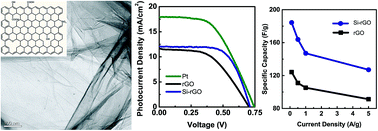Synthesis of silicon-doped reduced graphene oxide and its applications in dye-sensitive solar cells and supercapacitors†
Abstract
Heteroatom-doping of graphene is of fundamental importance to enable a wide range of optoelectronic and energy storage devices while exploring their basic material properties. Herein, a facile and low-cost method is presented to synthesize the silicon-doped reduced graphene oxide (Si-rGO) via annealing treatment of triphenylsilane and graphene oxide. Compared to the pristine reduced graphene oxide (rGO), Si-rGO exhibits significant enhancement in electrocatalytic and electrochemical properties: when Si-rGO is used as a metal-free electrocatalyst in counter electrodes in dye-sensitized solar cells (DSSCs), the conversion efficiency is increased by 29.6%; when Si-rGO is used as an active electrode in a supercapacitor, the specific capacity is increased by 48.5%. This suggests that silicon doping can effectively improve the electrocatalytic ability and electrochemical performance. It is promising for Si-rGO to be used as a metal-free catalytic and active material.


 Please wait while we load your content...
Please wait while we load your content...